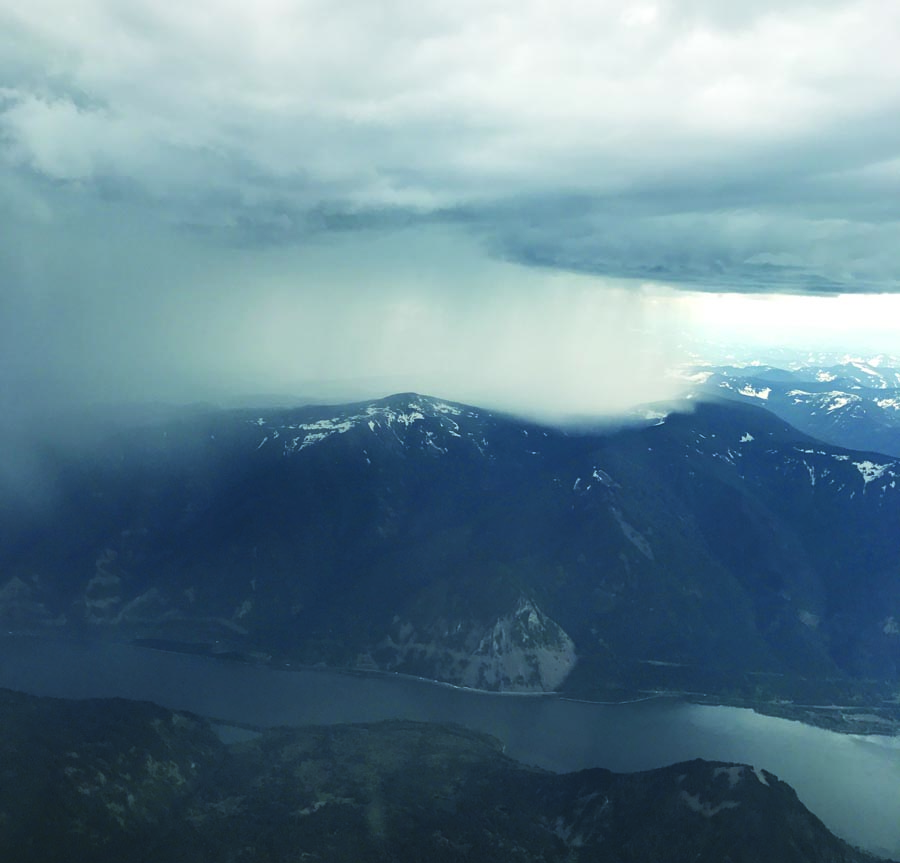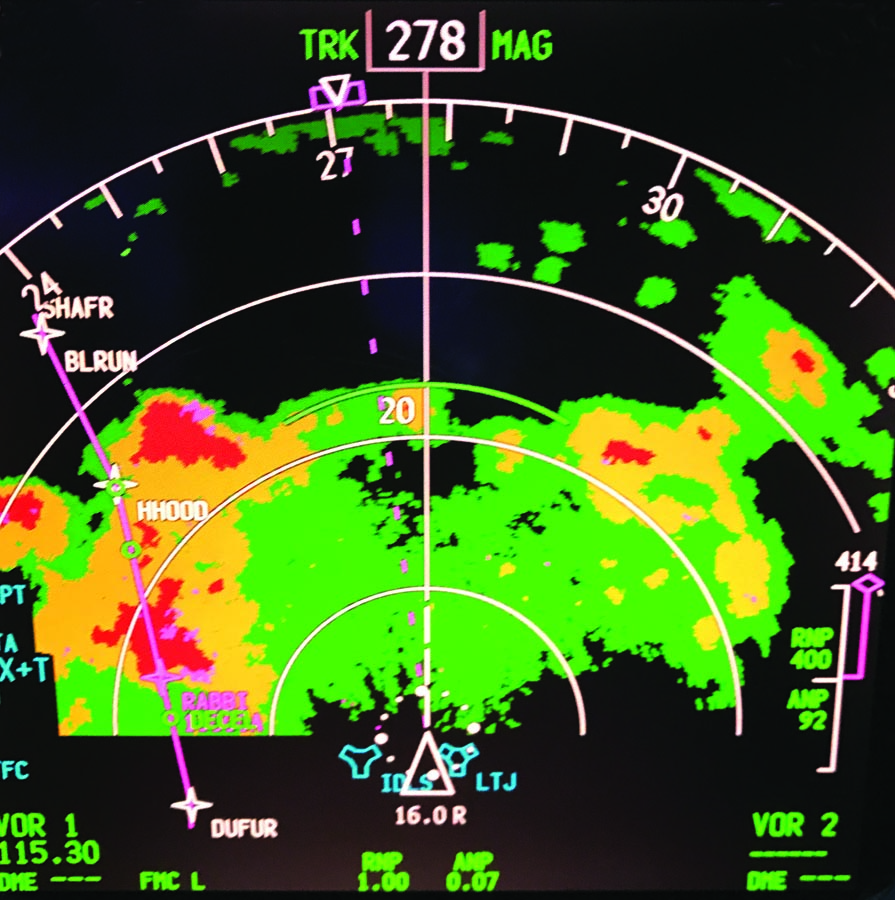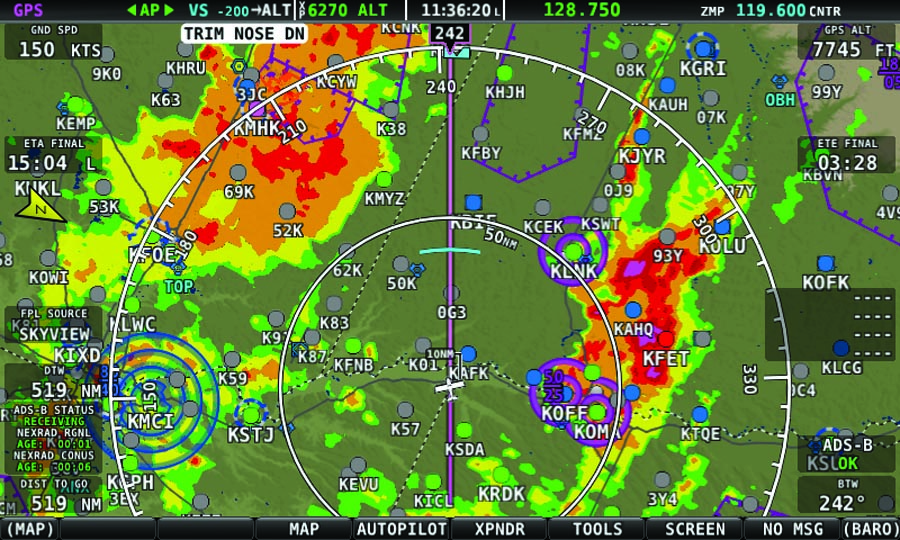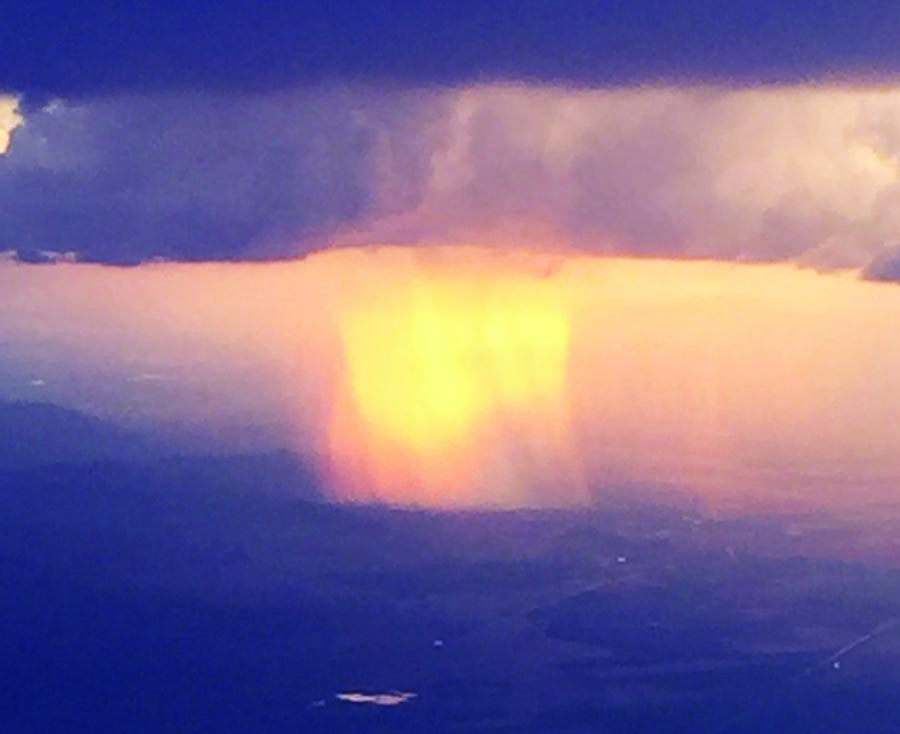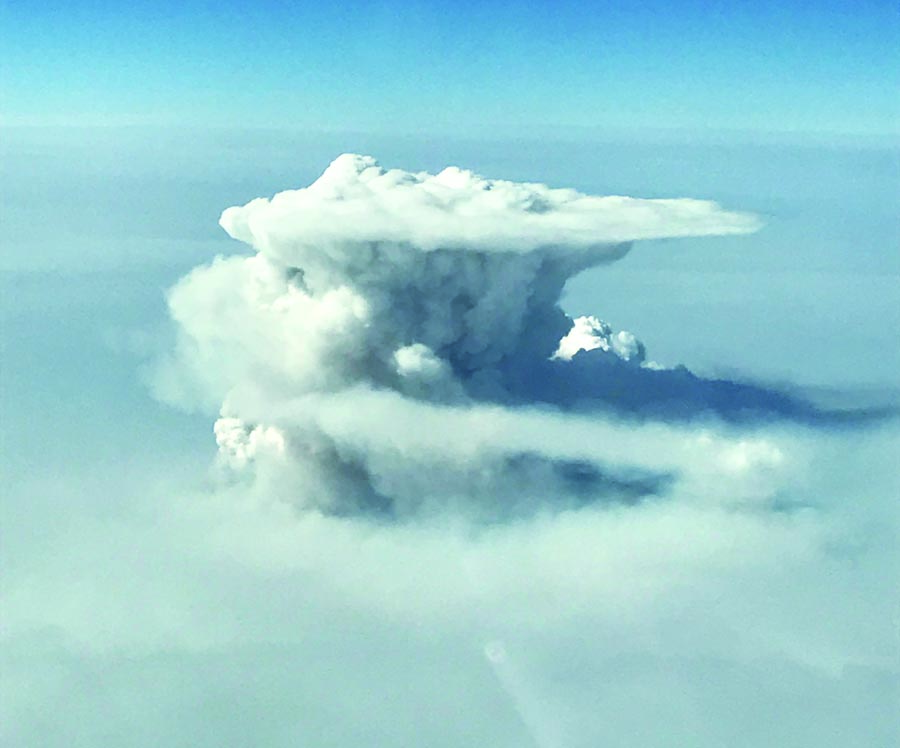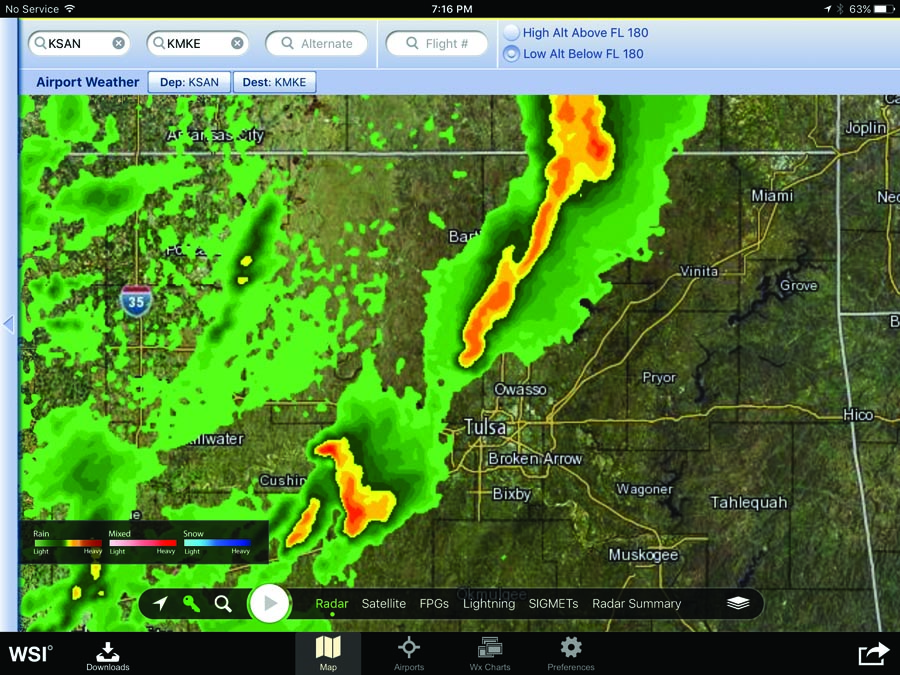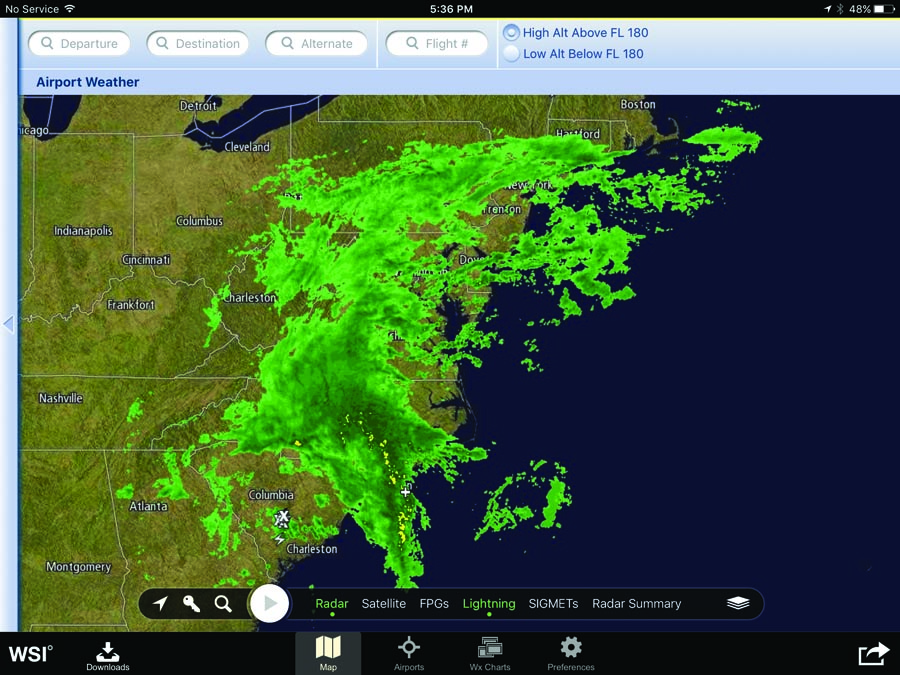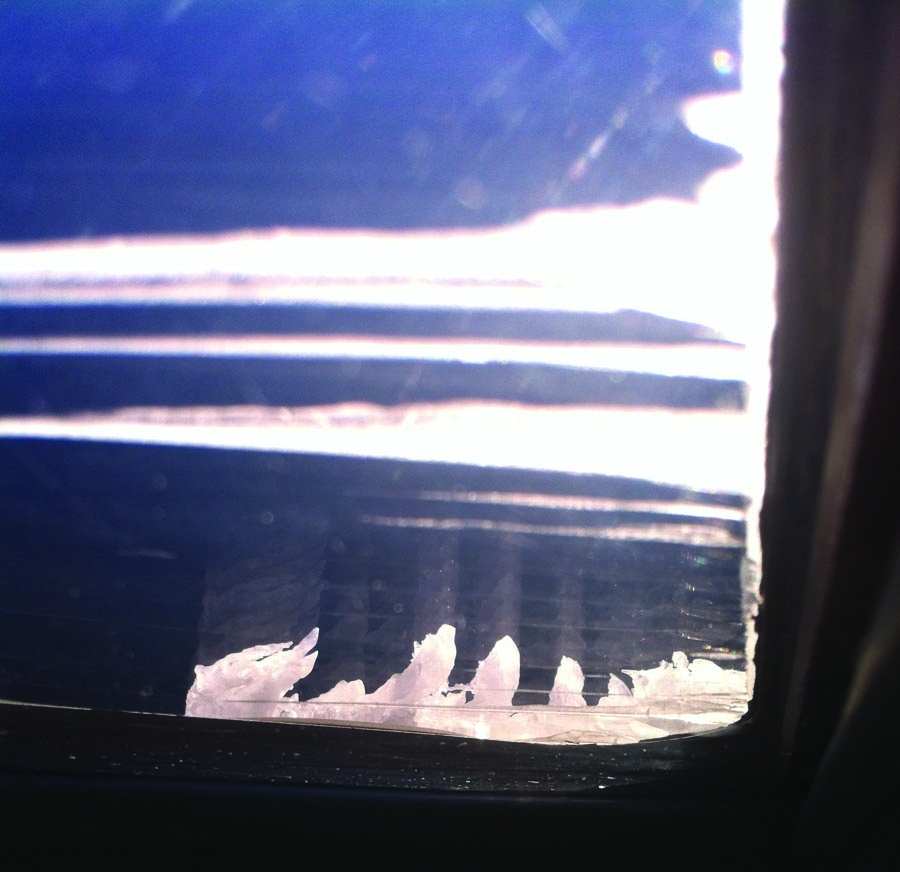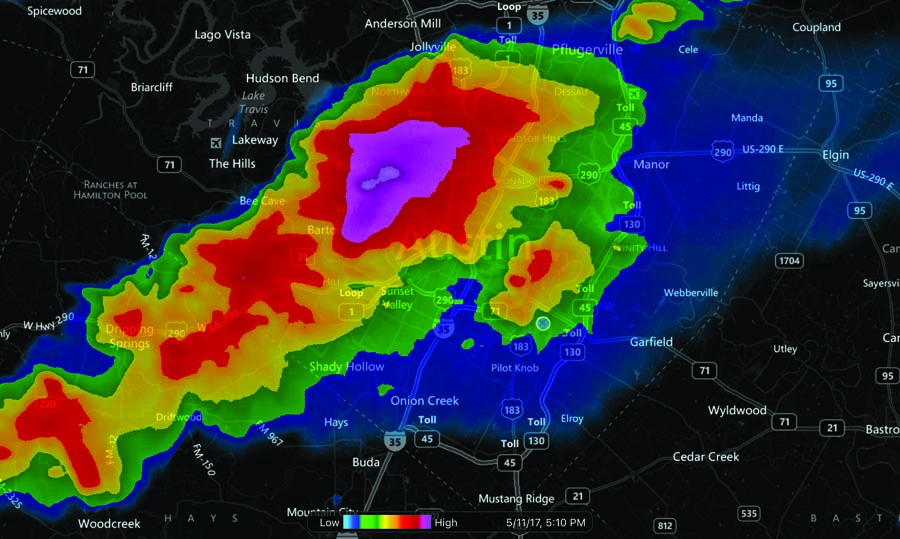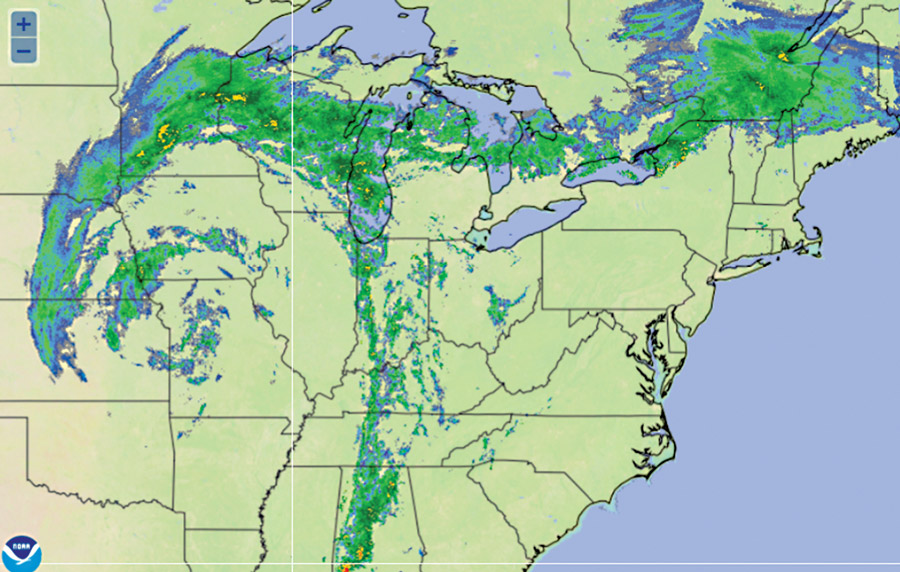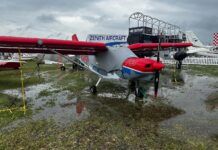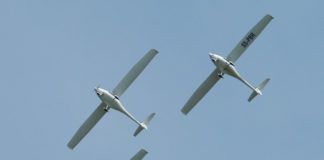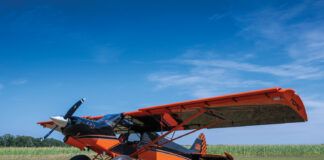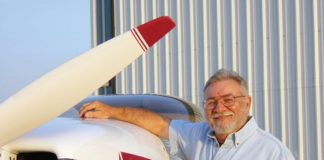Since before a lot of us were born, airliners have been using onboard weather radar to avoid dangerous storms and turbulence. The early units, while marvels for their times, were bulky, heavy, and expensive. They countered their nascent reception and interpretation abilities with massive wattage output, the axiom being that it was vital to turn off the system before taxiing into the gate if the poor marshaller ever wanted to be able to have children. The displays of the early units were monochromatic with very poor resolution.
As the technology improved from vacuum tubes to transistors to integrated circuits and beyond, the features improved, and the need for brute wattage output dropped dramatically. The bulk and size of the units shrank accordingly, allowing corporate-level aircraft to enjoy the benefits of weather detection. The systems eventually became a common albeit expensive addition for many light twins. The expense, plus the fact that there had to be a place for an antenna (the larger in circumference the better), left most of the single-engine market out of the game. There were a few wing pod models installed on Cessna Centurions and Piper Malibus, but I would hate to imagine what those units originally cost for the benefit they provided.
Enter NEXRAD
Several years ago, as ground-based radar technology improved, the federal government embarked on a program of covering the bulk of the country with a network of state-of-the-art weather radar stations. Today there are 176 stations in place with relatively few coverage gaps (mostly at lower levels near mountainous terrain). Other than the obvious benefit to aviation and maritime operations, one of the primary goals was to improve dangerous weather advisories to whole communities, especially for tornadic and hurricane type events where every additional minute of early warning is critical and can literally save lives.
Using today’s information superhighway, the data is continually gathered from all of the reporting sites into a central site where it is combined with other forms of data such as satellite data and ground activity reports and dumped into a Cray research-level computer to cook up the graphical depictions that we see today.
As NEXRAD was further developed, tweaked, and improved, it started to be more widely disseminated to the point where today it is available for free via several vendors on just about any smart device, as well as modern EFIS screens that have become mainstream, especially in the kit aircraft world. This is another area where our Experimentals are far advanced (and privileged) over our certified brethren. The costs of their equivalent systems can often exceed the costs of our complete aircraft.
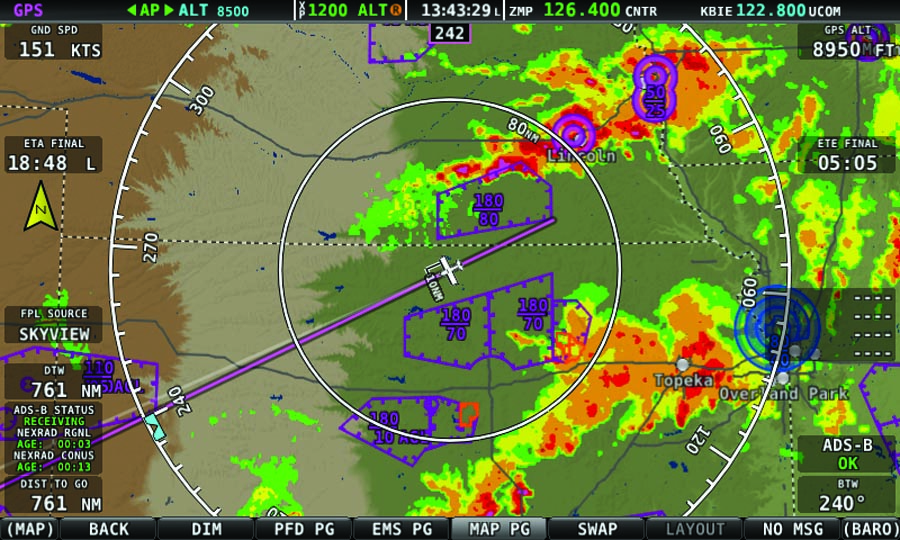
Weather and restricted areas near Lincoln, Nebraska, and Topeka, Kansas, while returning home from AirVenture.
As most readers already know, NEXRAD is also transmitted for free to aircraft that have the proper ADS-B In equipment installed. Now even Light Sport Aircraft can have technology that not so long ago, even the big-iron boys used to dream about.
In a reversal of the historical technology trickle down from military to airline to general aviation, NEXRAD, now common in newly minted Experimental aircraft, is just making its way into airline cockpits as a complement to onboard radar. We get it mostly through our new EFBs (electronic flight bags), which are nothing more than iPads stuffed with all the manuals and charts we used to carry in those backbreaking (but cool looking) leather Jepp bags. Comparing the two types of weather depiction, the information is complementary, but different. The goals, however, are the same. Air traffic controllers also now have a version of NEXRAD at most of their terminals, which is a massive upgrade to the nearly worthless weather data they had available previously.
I have always loved observing weather. I find it to be awe inspiring, even spiritual at times. Being immersed into the amazing atmosphere is one of the reasons I chose my vocation and my avocation. Having said that, I have learned to respect the immense power of Mother Nature. I have no desire to convert my kit aircraft back into parts, nor one of the Boeings I fly for a living, for that matter.
What Can NEXRAD Do?
Now that any kit aircraft driver can have access to NEXRAD, how can we use it to our benefit? The goal of all weather detection systems is to keep airplanes and their occupants safe and sound. One important fact that must be understood at the onset is that radar cannot detect turbulence. Like a smoke detector that portends fire by the presence of smoke, radar (I’ll use the term interchangeably for ship radar and NEXRAD) can only, at best, indicate where turbulence is likely versus unlikely. It isn’t an absolute science when it comes to airborne hazards. All experienced pilots have been hammered in perfectly clear air and flown through the deepest, darkest deluges with nary a burble. Often the most hazardous spot connected to a particular storm is in clear air adjacent to a storm rather than within its “painted” depiction.
It’s All About Water and Lift
What weather radar detects and depicts is water—rain, wet snow, wet hail. In contrast, everyday clouds, fog, choppy clear air, etc. do not paint returns, as those elements don’t bounce the signal back to the antenna like water does. Atmospheric water in its own right isn’t necessarily hazardous, but H2O is the key ingredient for what is hazardous.
Remember that insomnia-curing aviation weather manual that most of us read back in the day? The nasty brew starts when humid air encounters some kind of action that causes the moist mass to start to lift, and then science takes over in a fascinating way. The lifting action can be from a windy slope, a moving front, the effects of the hot sun baking the fruited plains, or even one of those ubiquitous “acts of God” buried in the fine print of our insurance policies. As the air mass rises, the gasses expand, condensing the moisture into visible cloud mass and concurrently releasing latent heat, which naturally rises and in turn fuels further lifting until the process can become dangerously self sustaining and accelerating. In weather reporting, the moist clouds with sufficient lifting action become CBs (cumulonimbus), then TCUs (towering cumulus), then TSs (thunderstorms) in weather shorthand. In a process that is beautiful to watch from the flight levels, the mushrooming towers can rise at a higher vertical rate per minute than most light aircraft can climb, often spawning offspring along the way. The lifting process is called convection, as in the “convective sigmets” and the like that serve to warn us. Not all CBs become TSs, but every TS started out as a CB.
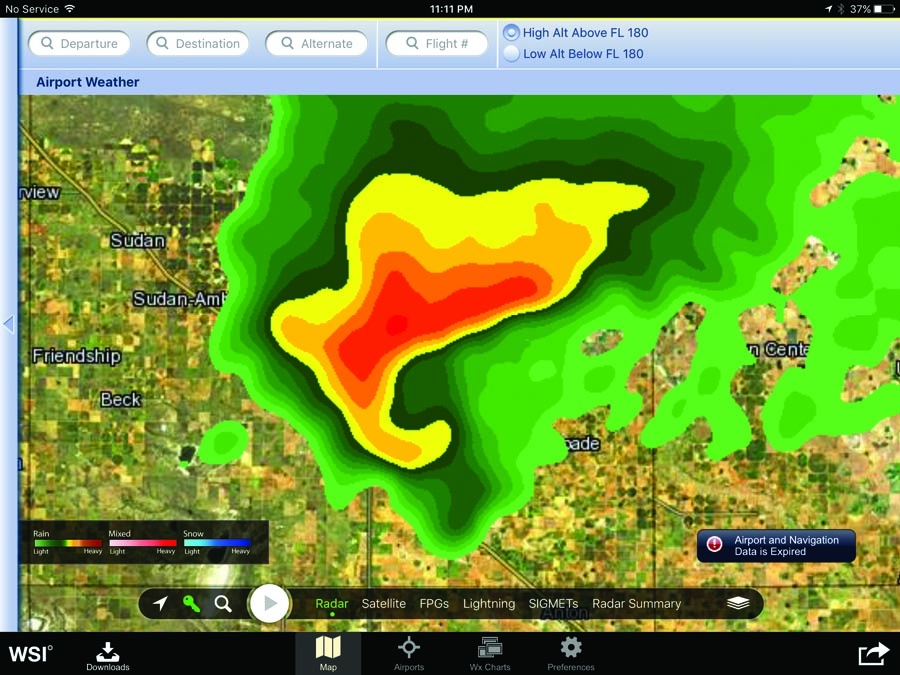
Stay away from areas of painted returns that show tight (narrow) gradients between the colors. Those are indicative of shear zones. Also avoid the classic “hook” area.
Green, Yellow, Red
The basic colors of NEXRAD and onboard radar are built upon the semaphore trio of green, yellow, and red. Different vendors have developed further shades of the classic three and even a new shade of blue for (calculated) snow, but for simplicity’s sakes we’ll stick to the basic three.
Green shows that something is triggering a return, but that it shouldn’t be hazardous. From experience of comparing the two side by side, NEXRAD paints a lot more green over a given area than does airborne radar over the same area. In theory, the ride quality over, under, or within a patch of green shouldn’t be any worse than the prevailing atmospheric conditions would have provided absent the painted return. Being within green returns, however, will most likely mean being IMC (in instrument conditions), which is a hazard in its own right depending upon the capabilities of the airplane and the pilot. Green at the very least means moisture laden clouds that can also present icing conditions. (See best practices to follow).
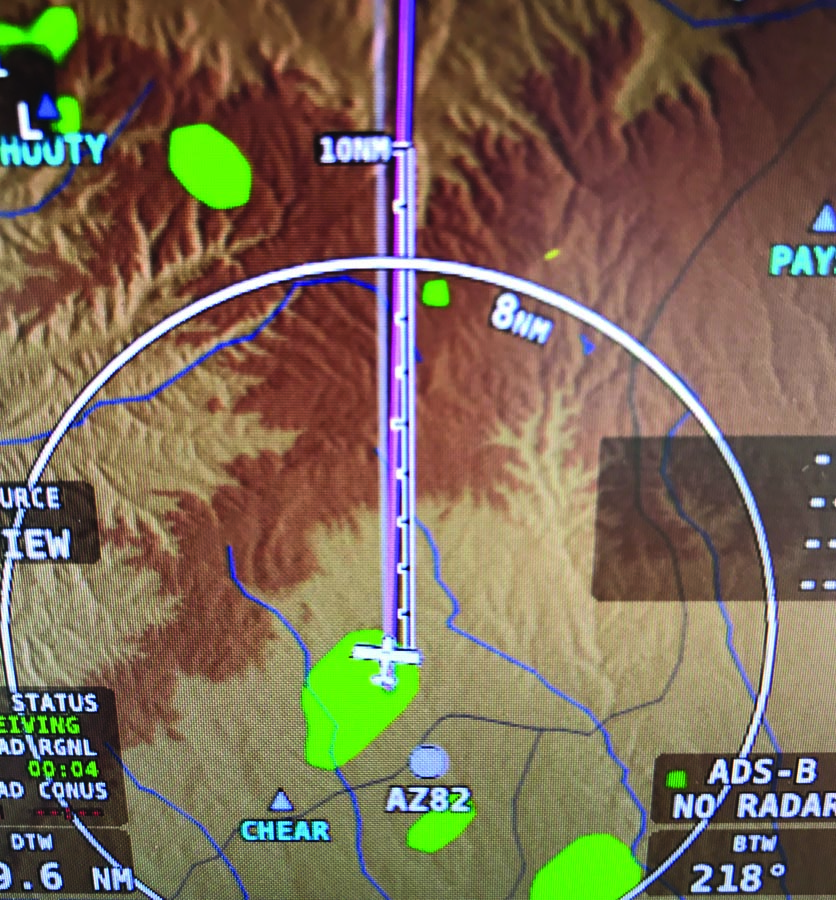
Artifact or false positive returns sometimes happen with NEXRAD. These small, smooth shapes with no contours or color shading are random odd weather returns that actually aren’t significant at all, just normal puffy clouds.
Yellow means heavy precipitation and a high likelihood of turbulence. Yellow is usually the least common color painted overall and often exists in a narrow band separating red from green.
Airline pilots don’t ever plan on traversing through yellow returns, although most have on occasions when the only alternatives were worse. Passengers and flight attendants have been seriously injured flying through areas depicted in yellow. General aviation aircraft have no business flying in or around yellow radar returns.
Oh Hail No!
Red is where the demon lives. Pierce the side of red and flutter out the bottom.
A Midwest country bumper painting red has as much kinetic energy within as a nuclear device. There are massive columns of angry air, rain, and likely hailstones that are all soaring skyward and/or even larger columns of angrier air, heavier rain drops and larger hailstones plummeting to earth at terminal velocity. The shear zones of air masses moving in different directions can spur lightning, tornadoes, severe turbulence, and can literally break an aircraft into pieces. The sheer volume of water in such behemoths has hydro-locked jet engines to the point were the laws of physics get angry, and the turning gear ejects itself aft, leaving nothing but empty cowlings with a few wires and hoses flapping in the wind.
Airborne hail can fracture windscreens or turn them opaque. It can also severely damage and distort airfoil leading edges, destroy antennas, etc.
The best way to tangle with red returns is in a simulator, but even there, if the sim is good, it can knock itself off its own control loading and even damage its hydraulics just trying to be accurate in its re-creation of the mayhem. Red rhymes with dead. Enough said.
Best Practices
• Now that most EFIS systems display both weather and terrain, become comfortable distinguishing between the two since they both use the core green, yellow, and red color schemes and often overlap, which might be confusing to the inexperienced. With practice it becomes intuitive to separate the two, as the color tones are more translucent for weather, and the respective return shapes and textures become more recognizable with experience. You can also toggle the respective layers off and on to compare and separate the two.
Some displays have indications for the tops of storms. The higher the tops of the storms, the more meteorological violence inherent within. There is wisdom in treating red weather returns as if they were red terrain returns—penetrating either will pretty much have the same result.
• One big advantage that NEXRAD has over onboard radar is that if your system supports CONUS displays, you can scroll to anywhere where weather is painting and gain practice in observing and interpreting the results from a safe distance.
• Airline procedures are to try to avoid moderate (yellow) returns by five miles and absolutely avoid severe (red) by twenty miles, especially at the freezing level and above. The reason for the buffer zones is that turbulence and even hail can exist in clear air in the vicinity of nasty storms. Airliners have a mission to get where they need to go. Most of us build our kit aircraft just for the pleasure of flying and have the luxury of time to be able to give storms a wide berth or even elect to fly on a different day.
• Give special clearance to areas of painted returns that show tight (narrow) gradients between the colors. Those are indicative of shear zones. Another danger sign is a depiction of “hooks” (see photo on above). Give that quadrant an extra wide clearance.
• Be aware of the OAT (outside air temperature). The worst areas for hazardous conditions are near the freezing level and colder. Rapidly rising water droplets can freeze an outer shell around a super-chilled, but still liquid or slushy, center. When these super-chilled droplets get burst by the impact of an invasive aircraft structure, they splatter and then freeze, covering the aircraft in thick, heavy ice that can accumulate at an alarming rate.
• Be aware of the winds aloft. It is generally more hazardous on the downwind side of a storm than on the upwind side. The “anvil” that often appears above a mature storm will point downwind and can extend for long distances. Do not fly under an anvil.
• Be aware of your screen range and switch it around often. Sometimes a decision on the best way to deviate your course around weather buildups looks much different at a longer range than a shorter one and vice versa.
• Being below dangerous weather can be as hazardous or worse than being abeam. Storm clouds appear dark because their moisture content blocks out light. A scalloped appearance at the base of a dark cloud is evidence of very turbulent conditions. Dangerous storms can be single entities that are easy to deviate around or, more often, exist in packs or frontal lines that can exist for hundreds of miles with dozens of clustered cells.
Maneuvering underneath a storm cloud layer is often a gauntlet of rain shafts and lightning bolts.
• Maneuvering underneath stormy areas is not for the inexperienced. There will often be a mixture of shafts of rain, along with “curtains” of lighter rain, both of which should paint to varying degrees on your NEXRAD display. However, your Mark One eyeballs are an important safety tool as well. Storms that have nearly dissipated themselves out will often have lingering remnants of light rain. In daytime, a curtain of light rain should still allow visibility of the horizon beyond it. But be prepared for that forward visibility to drop considerably when you penetrate the precipitation, simply for the obscuration on your windshield, which will clear back up when (if) you exit on the other side.
All bets are off at night. Shafts of heavy rain are as dangerous as the thunderclappers that produce them and are to be avoided just as judiciously. Downpours with rings of dust or visible debris roiling on the ground around them are signs of microbursts and can be lethal even to airliners.
• Lightning can occur below, abeam, within, and (rarely) even above thunderstorms. Strikes most often occur in clear air abeam or below the storm, sometimes miles from the mother storm. Some NEXRAD vendors have additional lightning depictions in their displays, but nothing can predict where lightning will appear in the future. The safest position is to simply steer well clear, as in the next state over.
Airliners are built to withstand lightning strikes, but light aircraft and their systems, not so much. If your airplane is struck by lightning in the air, you’ll know it. I’ve been struck three times in my airline career, and I remember each one vividly. There can be a bang like a fastball thrown at the airplane. If the strike is within your field of vision, there will be both a flash and a shower of sparks, and you can be temporarily flash blinded, especially right at the central focus of your eyes as the vision slowly returns from the periphery in. Depending upon where your fresh air intake is, you can even smell the “breath of God” ozone smell that is quite unique.
Lightning strikes can melt aluminum and delaminate composite material. I’ve seen a rivet head that melted and flowed back a quarter inch before solidifying again. I’ve also seen a softball-sized bubble formed on the inside of a composite nosecone. If you take a strike, land as soon as practical and have the airplane and all systems inspected by an expert. There will be entry point(s) and exit marks. The marks are commonly brownish with one or more dime-sized marks and often a few more BB-sized ones.
Other common occurrences associated with lightning strikes are electronic “queertrons” that show up hours or days after a strike that cause failures or anomalies in systems or components that at first inspection appeared to work fine. Looking over a ramp of several airliners, it is not uncommon to see one or more with fresh daps of paint along the top of the fuselage, often in an arcing line. Pretty much every airliner gets zapped a time or two in its career.
These are all good reasons to give a wide berth to convective activity.
Use NEXRAD Wisely
For aircraft that already have airborne radar, NEXRAD is a complement, not a replacement. The compilation and dissemination process to get the NEXRAD data to our screens is always improving, but it is at best minutes old in weather that takes mere seconds to change. It is a handy tool for longer- range planning and not intended for close-order maneuvering.
Having the opportunity to have free access to NEXRAD information in our cockpits can be a tremendous safety tool for the wise and cautious. Unfortunately, it can also be pixelated courage to the foolhardy. Mother Nature is marvelous to observe from a safe distance, but she always has a few tricks up her sleeve and loves to get the last laugh.
When I got my ADS-B module installed in my RV-10, I couldn’t wait to try it out. When a line of thunderstorms was rolling across our area, I immediately headed for the airport, pushed open the hangar doors, fired everything up, and soon marveled at how the screen depiction correlated to what I was viewing from the cockpit…Then the hail started, and I was very glad that my airplane and I were still safe under the protective roof of the hangar—that’s unquestionably the best place to be when convective activity is in the vicinity.

